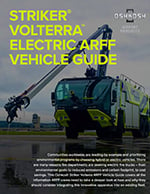
How does the Striker Volterra Electric ARFF Vehicle operate?
When powered by integrated onboard batteries, the Striker Volterra Electric ARFF operates with zero emissions. An internal combustion engine is incorporated as well to provide continuous power to the pumping or drive systems as needed.
While the design and operating mechanics of the Striker Volterra Electric ARFF vehicle is identical to the legacy Striker, the altered drivetrain allows for a 28-percent improvement in acceleration when fully loaded. This results in a critically important increased response time.
What is the Striker Volterra Electric ARFF Vehicle Drive?
When in electric vehicle (EV) drive mode, the Striker Volterra ARFF utilizes only its onboard batteries to power the vehicle fully on electricity. While this mode is most useful for reducing emissions and removing exhaust fumes (especially carbon dioxide), it also contributes to a significant decrease in noise pollution produced by the vehicle. EV drive mode on the Striker Volterra ARFF can be used for all primary driving processes. The day-to-day operation of the vehicle is identical to the conventional Striker ARFF, but it comes with highly reduced carbon emissions thanks in part to EV drive mode.
What is the plug-in electric vehicle configuration of the Striker Volterra ARFF truck?
The Striker Volterra Electric ARFF vehicle is configured as a plug-in electric vehicle. The vehicle can be operated in different ways to meet the individual needs of each department and is adaptable based on the available electrical resources in the area. The Striker Volterra ARFF truck can operate without a full charge; however, the plug-in charging system offers a more efficient solution and reduces the carbon footprint.
The Striker Volterra ARFF can charge from the standard 220 or 480 electrical grid and is not dependent on a specialized charging infrastructure. Customers may opt to install 480V 3-phase at 32 amps to support the Striker Volterra ARFF’s charging needs. ARFF vehicles typically do not experience the same volume of calls for service that a municipal apparatus does, so the need for fast charging, and the related expense, is a less critical consideration. If fast charging is important to the department, infrastructure investment would be a part of the planning process. Additionally, chargers could be integrated with renewable energy sources such as wind and solar, achieving further emission reduction.
What are the benefits of the Striker Volterra Electric ARFF Vehicle?
Electric vehicle innovations have been vital to the ability to meet sustainability goals without impacting operations or the safety of the traveling public.
Capabilities and benefits include:
How many Striker Volterra Electric ARFF Vehicles are currently on order?
Several Striker Volterra Electric ARFF Vehicles will go into service around the world in the coming months, including:

With increasing demand to meet environmental goals, ARFF crews are seeking ways to reduce their emissions and carbon footprint, while increasing cost savings. With this guide, you'll take a comprehensive look at what a fire department can expect from the innovative plug-in electric technologies of the Striker Volterra ARFF vehicle.
Fire and Safety Journals Americas: ADM Aéroports de Montréal enhances emergency response with new Oshkosh Striker 6×6 ARFF vehicles
TheBigRedGuide.com: Japan Ministry Of Defense Advances Towards Carbon Neutrality With The Acquisition Of An Oshkosh Striker Volterra Electric ARFF Vehicle
AirportImprovement.com: A First in Europe: Groupe ADP Secures Contract to Purchase Four Oshkosh Striker Volterra Electric ARFF Vehicles for Paris–Le Bourget Airport Rescue and Fire Fighting
AirportIndustryNews.com: DFW Orders Six Oshkosh ARFF Hybrid Electric Vehicles
